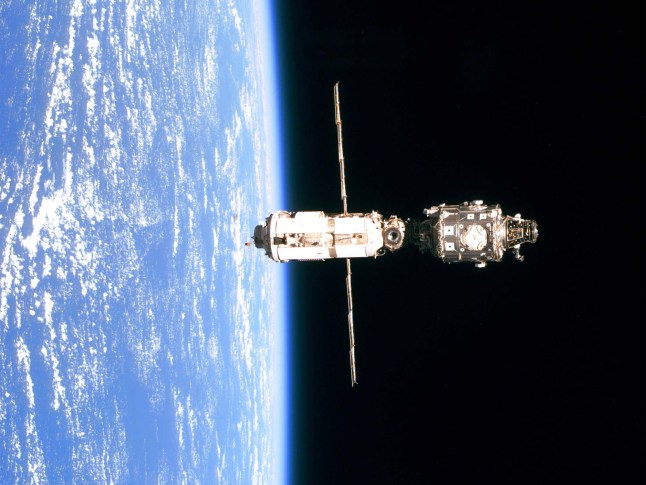
Barry ‘Butch’ Wilmore, 61, and Sunita ‘Suni’ Williams, 59, only planned to be floating in the endless abyss of space for a week. Eight days tops.
But the two Nasa astronauts have been stuck in the International Space Station since June after a raft of technical hiccups.
And they’ll be hundreds of miles above your head for a little while longer – Nasa confirmed that the February rescue mission has been pushed back.
SpaceX, the rocket maker owned by Elon Musk, needs another month to get its new Dragon capsule (Butch and Suni’s taxi home, basically) up and ready.
‘Fabrication, assembly, testing, and final integration of a new spacecraft is a painstaking endeavour that requires great attention to detail,’ Nasa’s Steve Sitch said yesterday.
This means the off-worlders will live in the ISS for roughly eight months.

But how will this affect Butch and Suni’s bodies?
Space, it’s pretty safe to say, is hostile to us Earthlings. There’s no gravity to keep you and all the bones and organs jiggling around inside of you in place.
Why stand when you can float?
‘Long-duration spaceflight is not good for the human body,’ says Dr Kirsty Lindsay, Assistant Professor in Rehabilitation Sciences within Northumbria University’s Aerospace Medicine and Rehabilitation Laboratory.
‘Floating in weightlessness means we don’t need to use our muscles or bones, so our bodies start to slowly reabsorb them.’
Standing up, for example, becomes pointless.
Muscles that help to maintain our posture – think back, neck, calves and quadriceps – diminish by as much as 20% in only two weeks.
This also includes the heart, which doesn’t have to pump as hard up in the stars as there’s low gravity. The muscle will shrink about 1/40th of an ounce a week.

Astronauts have to stay fit while on the ISS, which is basically kitted out with an entire gym, to combat this loss of bone and muscle mass, which is called ‘deconditioning’, says Liz Johns, the interim head of space exploration at the UK Space Agency.
‘This deconditioning is counteracted by a strict exercise regime that all astronauts keep up throughout their time on the International Space Station,’ she says.
Blood flow is a two-man operation. The heart pumps blood up while gravity drags it down. So, without its colleague, the heart is suddenly pushing up too much blood for our head to handle.
All this liquid pools in the back of our eyes, causing a condition called oedema which impacts the optic nerve and can develop in two weeks.
Some astronauts like Michael R. Barratt, who stayed on the ISS for six months in 2009, became more farsighted. He also had blemishes on his retina as his eyeballs were squeezed by all the liquid.
‘Puffy face and chicken legs’
When we suddenly have too much blood in our heads and too little in our legs, what will that do to Butch and Suni?
‘The answer is “puffy face and chicken legs”,’ Professor Mike Tipton from the University of Portsmouth’s Extreme Environments Laboratory (School of Psychology, Sport and Health Sciences) told Metro.

‘Caused by blood volume shifts in space due to microgravity. On return to Earth, gravity makes blood pool in lower extremities increasing the chance of fainting when upright.’
As their bodies adapt to weightlessness, Butch and Suni will likely lose weight. Most astronauts lose about 5% of their body weight during a four to six-month stay in orbit.
Bones demineralise and lose strength without gravity. As a comparison, older men and women lose 0.5-1% of their bone mass every year – astronauts lose up to 2% every month.
While our muscles and bones help us move, it’s the brain calling the shots. Researchers have found that extended stays in space can rewire the parts of our brain that specialise in movement and orientation, as was the case for a Russian cosmonaut who spent 169 days on the ISS a decade ago.
They might come back taller
We do, however, have good news for any 5’11” men who list themselves as 6′ on their Tinder bios. Without that pesky gravity squishing you down, people grow by about two inches when in space as their spines elongate.
However, this can lead to back pain while in space.
Gravity – or rather, the lack of it – isn’t the only major difference between life on Earth and in space.
Radiation is typically not a big worry for the inhabitants of Earth because the atmosphere acts as a cocoon, so most of it is deflected.
However, the ISS doesn’t have this high-level security system. High-energy atomic nuclei from exploding stars throughout the galaxy can penetrate spaceships, spacesuits and skin.

These big and heavy nuclei heighten the chances that astronauts will die of cancer as well as damage their DNA and crash into their white blood cells.
Things will also stay weird even when Butch and Suni finally reunite with Earth’s gravity.
‘When the astronauts return to Earth, and gravity starts to pull them downwards again this can cause problems,’ says Dr Lindsay.
‘The low blood volume can cause dizziness and fainting, with female astronauts particularly at risk in the first few days after their return. They will also both have to have a period of reconditioning exercise and training once back on Earth, which usually lasts around 45 days.’
The longest any human has been off Earth is almost 438 days, a title held by Dr Valery Polyakov on the Russian space station Mir in 1994 and 1995.
While spaceflight isn’t the most fun thing in the world for the human body, every trip, however short, is vital, says Dr Lindsay.
‘As missions go beyond Low Earth Orbit, visiting the Moon and Mars, the time spent in microgravity will get longer,’ she says, ‘so every opportunity we have to understand how to keep people healthy in space adds to our knowledge.’
Get in touch with our news team by emailing us at webnews@metro.co.uk.
For more stories like this, check our news page.
MORE: Homeowner finds whole mastodon jaw under his lawn
MORE: This is what a star 150 times bigger the sun looks like when it ‘hiccups’
MORE: Mystery of secret tunnels under one of UK’s most fascinating houses may finally be solved












